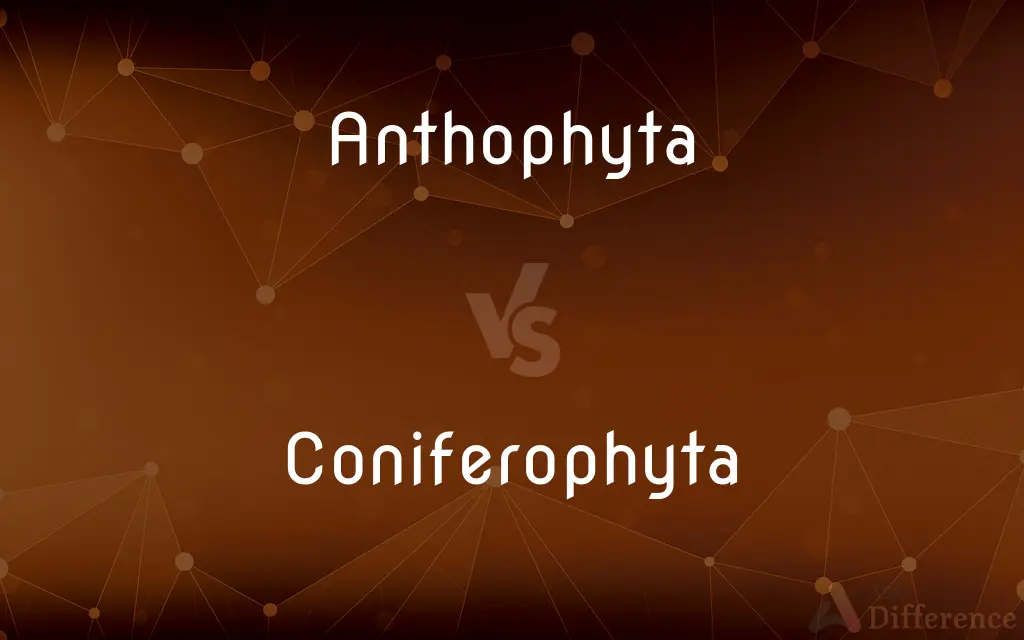Anthophyta vs. Coniferophyta — What's the Difference?
By Tayyaba Rehman — Updated on September 28, 2023
Anthophyta are flowering plants reproducing via seeds in fruits; Coniferophyta are cone-bearing plants reproducing through seeds in cones.

Difference Between Anthophyta and Coniferophyta
Table of Contents
ADVERTISEMENT
Key Differences
Anthophyta and Coniferophyta are distinguished divisions within the plant kingdom, each exhibiting unique reproductive strategies and structural attributes. Anthophyta, commonly known as flowering plants, are characterized by their production of flowers and seeds enclosed within fruits. They are the most diverse plant group, with examples ranging from grasses to large trees, and they reproduce sexually through the production of seeds via the fertilization of ovules within the flowers.
Coniferophyta, or conifers, are predominantly evergreen trees and shrubs characterized by needle-like leaves and the production of seeds within cones. This group includes pines, firs, and spruces, and unlike anthophytes, they do not produce flowers or fruit. Conifers rely on wind for pollination, and their seeds are typically exposed on the scales of the cones, rather than being enclosed within a fruit.
The diversity and adaptability of Anthophyta are notably vast, encompassing a wide range of habitats, from deserts to rainforests. They exhibit a variety of life forms including herbs, shrubs, and trees, and their flowering and fruiting structures can be incredibly diverse, reflecting the myriad ecological niches they inhabit. This adaptability has allowed anthophytes to become the most widespread and abundant group of plants on Earth.
Coniferophyta, on the other hand, are often associated with cooler, temperate, and boreal regions and are well adapted to withstand harsh environmental conditions. They play a crucial role in ecosystems, providing habitat and food for a multitude of species. Their adaptations, such as needle-like leaves and thick bark, enable them to conserve water and endure fire, cold, and nutrient-poor soils, emphasizing their ecological importance in less hospitable climates.
Understanding the distinct biological and ecological characteristics of Anthophyta and Coniferophyta is essential for appreciating the complexity and diversity of plant life on our planet. While both groups play pivotal roles in their respective ecosystems, their contrasting reproductive structures and adaptations underline the evolutionary diversity within the plant kingdom.
ADVERTISEMENT
Comparison Chart
Reproductive Structures
Produces flowers and seeds are enclosed in fruits.
Produces cones and seeds are exposed on cone scales.
Leaf Structure
Typically has broad leaves.
Possesses needle-like leaves.
Habitat
Diverse, found from deserts to rainforests.
Typically found in cooler, temperate, and boreal regions.
Diversity
Most diverse and abundant plant group on Earth.
Less diverse compared to Anthophyta.
Fruiting Bodies
Produces fruit as a result of flower fertilization.
Does not produce fruit; seeds are borne directly on cones.
Compare with Definitions
Anthophyta
Plants that produce seeds enclosed in an ovary, typically known as flowering plants.
Anthophyta include species from delicate orchids to substantial oak trees, showcasing their extensive variety.
Coniferophyta
A division of plants known for bearing cones and having needle or scale-like leaves.
Coniferophyta are often predominant in colder regions, offering resilience to harsh climates.
Anthophyta
The largest group of plants characterized by sexual reproduction through flowers.
The presence of Anthophyta is ubiquitous, spanning various habitats and environments.
Coniferophyta
Evergreen trees and shrubs that usually bear cones and do not produce flowers or fruits.
The enduring leaves of Coniferophyta allow for adaptations to environments with resource limitations.
Anthophyta
A division of plants that produce flowers and seeds within fruits.
The vast diversity of Anthophyta is evident in the myriad of flowering plants observed in ecosystems globally.
Coniferophyta
Plants characterized by the production of seeds without an enclosing fruit.
The unique reproductive structures of Coniferophyta differentiate them from flowering plants.
Anthophyta
The plant division comprising species that undergo sexual reproduction to form seeds enclosed in fruits.
The proliferation of Anthophyta is facilitated by their adaptability and varied reproductive mechanisms.
Coniferophyta
A group of gymnosperms known for their needle-like leaves and production of seeds on cones.
The presence of Coniferophyta is crucial in many ecosystems, contributing to biodiversity and ecological balance.
Anthophyta
A plant group where fertilization occurs within flowers, leading to fruit production.
Anthophyta's reproductive strategy allows for the development of diverse fruit and flower structures.
Coniferophyta
The plant division including trees and shrubs that bear cones and have leathery or needle-like leaves.
Coniferophyta, with their distinct cones and leaves, are vital components of terrestrial biomes.
Anthophyta
The anthophytes are a grouping of plant taxa bearing flower-like reproductive structures. They were formerly thought to be a clade comprising plants bearing flower-like structures.
Coniferophyta
A class of cone-bearing gymnosperms dating from the Carboniferous; most are substantial trees; it includes the classes Pinopsida (subdivision Pinophytina) and Ginkgopsida (subdivision Ginkgophytina) and Taxopsida (subdivision Taxophytina) which in turn include the surviving orders Coniferales and Taxales (yews) and sometimes Ginkgoales as well as extinct orders such as Cordaitales (of the Carboniferous and Permian) and Volztiales (of the Permian-Jurassic).
Anthophyta
Comprising flowering plants that produce seeds enclosed in an ovary; in some systems considered a class (Angiospermae) and in others a division (Magnoliophyta or Anthophyta)
Coniferophyta
Cone-bearing gymnosperms dating from the Carboniferous period; most are substantial trees; includes the classes Pinopsida (subdivision Pinophytina) and Ginkgopsida (subdivision Ginkgophytina) and Taxopsida (subdivision Taxophytina) which in turn include the surviving orders Coniferales and Taxales (yews) and sometimes Ginkgoales as well as extinct orders such as Cordaitales (of the Carboniferous and Permian)
Common Curiosities
Are all Coniferophyta evergreen?
While many conifers are evergreen, not all Coniferophyta are; some do shed their leaves annually.
Do Coniferophyta produce fruits?
No, Coniferophyta do not produce fruits; they bear seeds directly on the scales of cones.
Can Anthophyta be found in desert regions?
Yes, Anthophyta exhibit remarkable adaptability and can be found in a range of habitats, including deserts.
Do all Anthophyta produce fruits?
Yes, all flowering plants or Anthophyta produce fruits, which contain the seeds.
Are Anthophyta primarily trees?
No, Anthophyta include a diverse range of life forms, including herbs, shrubs, and trees.
Are Anthophyta the only plants that produce flowers?
Yes, Anthophyta, or flowering plants, are uniquely characterized by the production of flowers.
Do Coniferophyta have a higher tolerance to cold than Anthophyta?
Generally, yes. Many conifers are adapted to cold environments and can tolerate extreme cold better than most flowering plants.
Is Anthophyta the most diverse plant division?
Yes, Anthophyta is the most diverse plant division, with the greatest number of species.
Can Coniferophyta survive in nutrient-poor soils?
Yes, many Coniferophyta have adaptations that allow them to thrive in nutrient-poor soils.
Do Coniferophyta have broad leaves?
Typically, no. Most Coniferophyta have needle-like or scale-like leaves.
Do Anthophyta rely on wind for pollination?
Some Anthophyta are wind-pollinated, but many rely on animals or water for pollination.
Do Anthophyta species usually have a longer lifespan compared to Coniferophyta?
Lifespan varies widely within both groups, with some Coniferophyta living thousands of years, outliving many Anthophyta.
Are Coniferophyta found in tropical climates?
While less common, some species of Coniferophyta do exist in tropical climates.
Is the bark of Coniferophyta usually thick?
Yes, many conifers have thick, protective bark that aids in their survival in harsh conditions.
Is it true that all Anthophyta have seeds enclosed in an ovary?
Yes, a defining characteristic of Anthophyta is that their seeds are enclosed within an ovary, which usually develops into a fruit.
Share Your Discovery

Previous Comparison
Ligament vs. Aponeurosis
Next Comparison
Fold vs. MoldAuthor Spotlight
Written by
Tayyaba RehmanTayyaba Rehman is a distinguished writer, currently serving as a primary contributor to askdifference.com. As a researcher in semantics and etymology, Tayyaba's passion for the complexity of languages and their distinctions has found a perfect home on the platform. Tayyaba delves into the intricacies of language, distinguishing between commonly confused words and phrases, thereby providing clarity for readers worldwide.















































